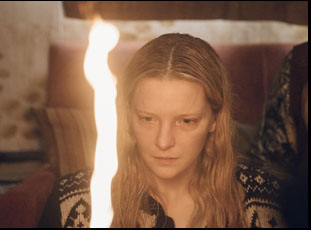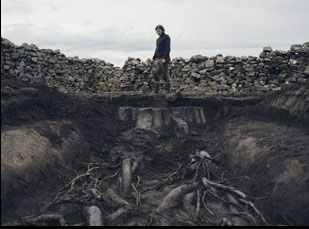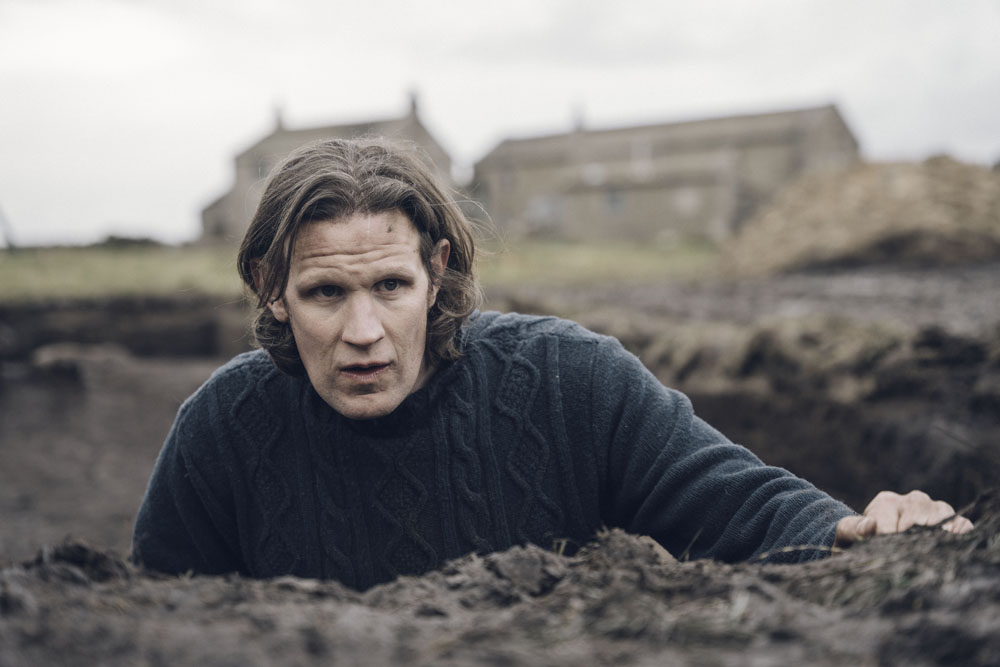Although audiences are bound to hold their breath during “Starve Acre,” that response has allowed Daniel Kokotajlo to exhale a bit as he’s set about releasing his second feature.
“I’m just relieved that it’s working for people, especially in the States,” said Kokotajlo. “I had no idea how people would react to this kind of creepy, weird British film, but it seems to be working for a lot of people, so I’m very happy.”
It couldn’t be a total surprise when on a recent Zoom call from his office, you could see over his shoulder the poster of another creepy, weird British film that captured audiences’ imagination in “The Wicker Man” and Kokotajlo joins a fine tradition in contributing to the folk horror genre with this unsettling adaptation of Andrew Michael Hurley’s novel about Richard (Matt Smith) and Juliette (Morfydd Clark), a couple that has come to the countryside to resettle for his job at a university and finds their young son Owen (Arthur Shaw) adapting a little too well to his new surroundings, learning from a neighbor about superstitions that have bedeviled the area for generations. Having been raised there himself, Richard discourages him from following his curiosity about learning more about his roots — or at least, the tree once sat in the middle of their farm, now cut down to a stump – but when tragedy strikes, both his parents start to take a greater interest in the land, even coming to belief that the sprit of their son has insinuated itself in a hare.
As grief sets in, what’s surreal to outsiders becomes the most tangible to Richard and Juliette as they struggle to hold onto reality and while they blocked out myths before about the property they bought, they can no longer ignore the hearsay. An audience is bound to become believers as well when Smith and Clark deliver such committed turns as the tortured couple that can barely recognize one another upon losing their son and gingerly reappproach a renewed partnership when the possibility looms that they haven’t lost anything at all. Their tumultuous relationship is complimented by a perpetually evolving score for a story that takes place over the span of four seasons, with nature in every respect never content to settle, and the film marks a bit of a turn as well for its director, who drew on his personal experience of moving away from a Jehovah’s Witness community to see it more clearly in his debut “Apostasy,” to show his genre chops while still considering how perspective can be warped by emotion. After premiering last fall at the London Film Festival, “Starve Acre” is arriving in the U.S. this week and Kokotajlo spoke about how he could feel closer to a story when he didn’t originally write it himself, the games nature played with him and making sure his actors had some real to act against with a bevy of practical effects and puppetry on set.

I was already aware of the author Andrew Hurley’s work. I’d read both of his books before “Starve Acre” and I loved his style. He’s quite famous over here for gothic storytelling and then I was actually talking to a producer about Andrew’s work and they mentioned that “Starve Acre” was coming out, so I got hold of a promo copy of it, read it and loved what it was doing and what it was trying to say about springtime and rebirth and resurrection, so that’s how it started.
Was it interesting to take on an idea that you didn’t originate yourself, especially in light of your debut feature “Apostasy,” which was so personal?
Yeah, it was easier for me in that way. “Apostasy” took a lot out of me because of how personal it was, and I was actually working on another project that was a continuation of that. But I decided after “Apostasy” had come out and everything I’d been through that I didn’t really go through that same experience again, so “Starve Acre” felt like I had the ability to deal with a similar subject, but disconnect myself from it in a way, though it’s surprising when you look at it how similar Starve Acre is to “Apostasy.” It’s got the same subject, really, and I think I connect with Andrew’s work because we’re both from the north of England and we love the countryside there and the Dales and the Moors. We both like to tell stories that have a strong sense of place as well, and how that represents certain emotions and characters, so I got excited about doing that. This was on the other side of the hills in the Yorkshire Dales, so it was great to go over there and to spend time up north again.
From the film, it looks like you shot across seasons, but as I understand it, the weather wasn’t always cooperative. What was this like to pull off?
I could talk about that for ages, but we shot in late winter, early spring in the hopes to try and capture winter at the beginning of the shoot and then get a summery feel at the end. But it didn’t work out because the first week we had a heat wave, so we had to have all snow machines out. And after the first week of shooting, I was embarrassed by the footage because it just did not look good at all. The second week, it was all interiors, and then I looked outside and it was an amazing snowstorm outside, so I just said, “Look, we’re going to go back out and reshoot some of this stuff in the snow again.” That’s how we managed to capture that sense of all seasons and it was all shot in the space of four or five weeks, so I was able to adapt to what was happening, but it was hard. And some of the crew got upset about it, having to suddenly switch and go back outside in the middle of a snowstorm. But I couldn’t live with myself if we didn’t do it.
You pulled it off so well, and the light comes into the house, I was so struck by the evolution of that throughout and wondered how it was coordinated?
Yeah, there’s this sense of something being brought into our lives when this thing happens, which is a symbol of springtime, that it does change the atmosphere and it changes the light and the color palette of the film as well. And that was about being sensitive to the actors [too], like not judging them despite what was happening. Even though these are horror moments for an audience, for them, it was like there was no other answer. It’s the only thing that they had to move forward, so it was always about doing that, portraying it through their eyes and [the mise-en-scene] and a lot of times as the film went on, there was a strong, harsher light or a stronger colour, but more saturated.
I understand with Matt Smith and Morfydd Clark that it was interesting working with them on the day, and these seem like tricky performances to help guide because they’re so internal and fluid. What it was like working with them on this?
They’re both great, and it was about working out how they like to work. Luckily, they like to adapt and look for a more truthful way through the scene and quite often I was having to incorporate multiple scenes into one because things were going wrong. I was losing locations, and I would turn up on the day with a new a new scene, essentially, and they were excited by that. That just meant we needed to block a little bit longer, rehearse again and find out a way through it. And Matt loves to do that. He loves to keep the camera rolling and shoot seven or eight different versions of it, to keep digging and working out what it is, so it was great to see him work in that way, and [Morfydd] did so much research and homework into it that she nailed it every time. She knew what it was before she got there and she was quite a different actor to Matt in that way, actually. She had it in a system somehow.

Mainly just that they really got on with each other. That was the thing I was nervous about, and I think any director is. Will there by any chemistry? But luckily, they’ve just got on like a house on fire and I think they had a lot in common, coming off the back of two big shows [“House of the Dragon” and “The Rings of Power”] and they got to share a lot of their experiences on that, so I think they were both in a similar position where they wanted to be on on location and get their hands dirty and shoot in an old fashioned way. They were both equally excited by that, and I felt lucky with that. It didn’t really change the way I was working, and there were only so many scenes where they’re actually close to each other.
It didn’t surprise me afterwards to learn that you used puppets because the rabbit on screen appear so realistic, but it was surprising only for the fact that it seems to have fallen out of fashion as a technique. For as much work as it was, was that an exciting part of this for you?
Yeah, that was the number one question after I’d finished reading the novella is how do you execute this? My first instinct was it made me think of the film “Alice” by Jan Svankmajer, which was all stop-motion, and I looked into that, but it was just too hard to do on the budget and schedule. Then the next option really was animatronics and puppetry and I got excited by that. I’m a big Jim Henson fan. I love “Dark Crystal” and “Labyrinth” and I really got into talking to the puppeteers and rehearsing with them. It’s an amazing craft and it felt appropriate for this story that was set in the ’70s because this is the way they would have done it [then]. The option of using a real hare wasn’t even on the table because you can’t train a real hare — they’re so timid and nervous that apparently they die before you could train them. We did actually we did have two real Belgian hares [on set], and there’s a couple of shots in the film where I am using a rabbit, but you just see the back end of it and you can’t quite tell. Most of it’s puppet work.
The score works quite well to evoke the many moods of the film, particularly when it’s so eclectic. What was it like to work on?
Yeah, every aspect of the film I obsessed over really, and [music] was a big one because all the way through the book, it was so descriptive of the land and also the sense of this wood sprite [said to live there] and how it whistles to people through the woods. That was something I latched on to, so that’s where I started to build on sound-wise and developed ways to subvert the sound of leaves through trees and [thought] how do you then turn that into a piece of music that entrances the characters in the story and make it a bit atonal? Those are all things I was dealing with and [I was working with] the sound designer and the composer at the same time and now when I watch it, I don’t really know which which one is sound design and which is score anymore.
Those are often separate departments on movies. Did you know from early on that you’d bring them together?
Yeah, we had chats at the beginning [about] the atonal aspects of the score and where it blends in and out of the sound design, and then the sound designer was the mixer as well, so he was then able to adjust things accordingly. It’s funny because Matthew Herbert, the composer, had a concept album he was releasing called “Horse” and he bought a skeleton of a horse and made the whole album out of the bones, so it was like making rhythmic elements and then turning certain bones into whistles and things and he created this whole piece just out of a skeleton and then he did it on stage. I went to the Barbican Theatre and watched it there and he goes on stage and starts making beats and whistles and by the end of the show, it’s like a full orchestra and this horse is reanimated, dancing on stage [with] puppeteers operating it, so I was like, “Wow,” it was a great audition for the film.
“Starve Acre” opens theatrically on July 26th in Los Angeles at the Lumiere Cinema at the Music Hall. It is also available on VOD.




